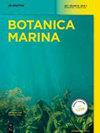研究阻力对漂浮大型藻类轨迹模式影响的数值实验
IF 1.4
4区 生物学
Q2 MARINE & FRESHWATER BIOLOGY
引用次数: 0
摘要
洋流是在海洋表面散布自然和人为物质的重要途径。大型藻类是最显著的自然散布者之一,常被称为 "海洋中的风滚草"。尽管对这一主题进行了大量研究,但风和表层流对大型藻类扩散轨迹的相对影响仍不确定。以往的研究主要集中在大小不一的海带筏上,因此很难确定风和海流的影响。这些研究还忽略了大型藻类的阻力特性和表面积,而这些因素已被证明会影响漂浮物的轨迹和堆积。这项数值研究旨在阐明风和水流的相对影响,以及阻力在决定大型藻类的运动轨迹和堆积过程中的作用。通过比较包含阻力和不包含阻力的虚拟海带 "颗粒 "的模拟结果,本研究重点关注孤生海带植物,并考虑了形态特征、流场组合和斯托克斯漂移的影响。我们的研究结果表明,虚拟海带粒子一般会跟随洋流,但加入阻力后,粒子的轨迹会偏离纯拉格朗日粒子的轨迹,这也揭示了影响大型藻类在海洋中扩散的各种因素之间复杂的相互作用。本文章由计算机程序翻译,如有差异,请以英文原文为准。
Numerical experiments investigating the influence of drag on trajectory patterns of floating macroalgae
Ocean currents are a crucial means of dispersing natural and human-made materials on the ocean surface. Macroalgae are among the most conspicuous natural dispersers, often called the ‘tumbleweeds of the ocean.’ Despite numerous studies on the subject, the relative influence of wind and surface currents on the trajectory of macroalgal dispersal remains uncertain. Previous studies have focused on kelp rafts of varying sizes, making it challenging to determine the impact of wind versus currents. These studies have also disregarded the macroalgae’s drag characteristics and surface area, which have been shown to impact the trajectory and accumulation of floating flotsam. This numerical study aims to shed light on the relative influence of wind and currents and the role of drag in determining the course and accumulation of macroalgae. By comparing simulations of virtual kelp ‘particles’ that incorporate drag and those without, this study focused on solitary kelp plants and considered the impact of morphological characteristics, flow-field combinations, and the presence of Stokes drift. Our results show that virtual kelp particles generally followed ocean currents, but the inclusion of drag caused deviations from purely Lagrangian particles’ trajectories and sheds light on the complex interplay of factors affecting macroalgal dispersal in the ocean.
求助全文
通过发布文献求助,成功后即可免费获取论文全文。
去求助
来源期刊

Botanica Marina
生物-海洋与淡水生物学
CiteScore
4.10
自引率
4.50%
发文量
43
期刊介绍:
Botanica Marina publishes high-quality contributions from all of the disciplines of marine botany at all levels of biological organisation from subcellular to ecosystem: chemistry and applications, genomics, physiology and ecology, phylogeny and biogeography. Research involving global or interdisciplinary interest is especially welcome. Applied science papers are appreciated, particularly when they illustrate the application of emerging conceptual issues or promote developing technologies. The journal invites state-of-the art reviews dealing with recent developments in marine botany.
 求助内容:
求助内容: 应助结果提醒方式:
应助结果提醒方式:


